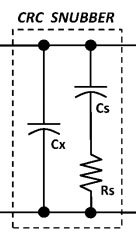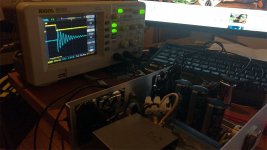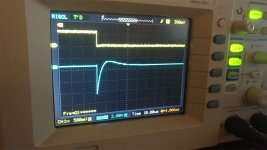I have about 100 78's and modified an old mid-fi Thorens TD-115 for playing them, pretty easy.
I also have a pair of SL1200's, an MK2 and an M3D. Completely different control. KAB will modify the MK2 for use with 78's -- for $175 which seems reasonable. Has anyone tried something similar.
I also have a pair of SL1200's, an MK2 and an M3D. Completely different control. KAB will modify the MK2 for use with 78's -- for $175 which seems reasonable. Has anyone tried something similar.
I just measured the stock transformer with the Quasimodo jig to get a proper snubbing network to replace that 220nF cap.
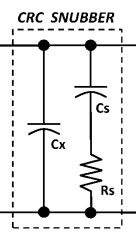
The values are
Cx: 10nF
Cs: 150nF
Rs: 270R
This is for a primary wired for 230V.
Sorry no measurements yet for 110V, but with something like 250R you should be close enough for a first evaluation.
And here are some scope captures
With just the 10nF cap attached. Quasimodo ringing the bell full strength.
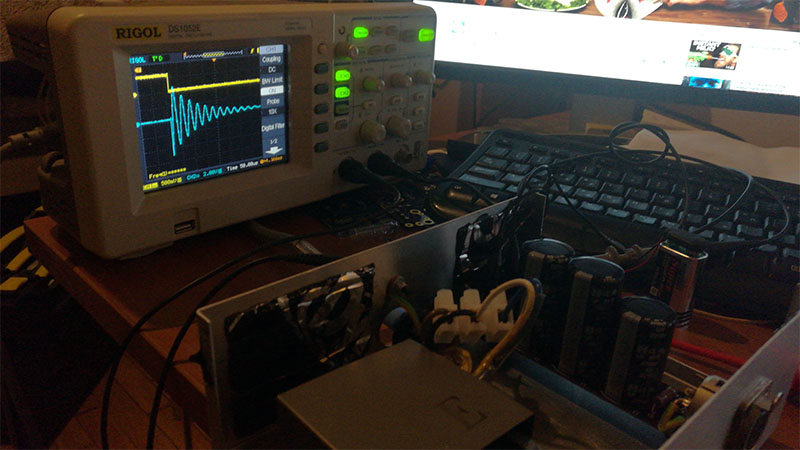
And here is what's left of the ringing with the values above.
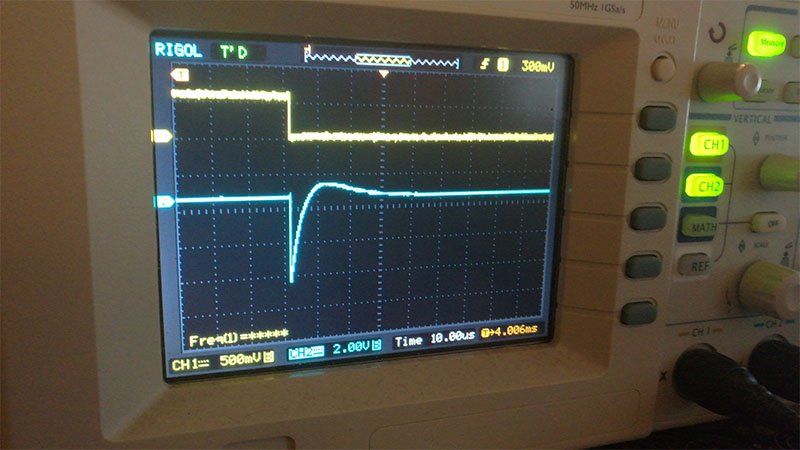
The values are
Cx: 10nF
Cs: 150nF
Rs: 270R
This is for a primary wired for 230V.
Sorry no measurements yet for 110V, but with something like 250R you should be close enough for a first evaluation.
And here are some scope captures
With just the 10nF cap attached. Quasimodo ringing the bell full strength.
And here is what's left of the ringing with the values above.
Attachments
Hi,
smps is what I do.
You not only get the general benefits of a improved supply, but even more.
One is, that You can have it all at such small size that You can keep all electronics inside, preserving the original optics.
There are no issues with mounting a SMPS internally ... in fact, keeping all traces short is beneficial.
Decent SMPSs already supply with very constant verylow ripple voltages.
The highfrequency switching residuals can very effectively be post-filtered with highquality and compact parts.
The output voltage of the SMPS can be chosen nearly 1/3 lower than original, consuming/wasting less power, generating less heat power losses in the post-regulation parts.
Accordingly a lower wattage SMPS is useable.
In fact it can be better if the wattage is lower, as switching supplies like a certain loading anyway (~70% of full load seems good).
A 24V/10W type works perfectly ... 15V for the smaller Technics (here, as small as 5W may suffice).
But the best is, that due to their ultrasonic switching, they are quiet .... dead quiet
jauu
Calvin
smps is what I do.
You not only get the general benefits of a improved supply, but even more.
One is, that You can have it all at such small size that You can keep all electronics inside, preserving the original optics.
There are no issues with mounting a SMPS internally ... in fact, keeping all traces short is beneficial.
Decent SMPSs already supply with very constant verylow ripple voltages.
The highfrequency switching residuals can very effectively be post-filtered with highquality and compact parts.
The output voltage of the SMPS can be chosen nearly 1/3 lower than original, consuming/wasting less power, generating less heat power losses in the post-regulation parts.
Accordingly a lower wattage SMPS is useable.
In fact it can be better if the wattage is lower, as switching supplies like a certain loading anyway (~70% of full load seems good).
A 24V/10W type works perfectly ... 15V for the smaller Technics (here, as small as 5W may suffice).
But the best is, that due to their ultrasonic switching, they are quiet .... dead quiet
jauu
Calvin
Forgot to look at the maximum output current...
Anyone know what sort of current is required?
Hi,
You may use a Meanwell PM-10-24, encapsulated, PCB mount, small size SMPS.
Beeing labelled 'medical' its rated as high reliability (high MTBF figure) and low leakage.
It comes with severeal useful protections like overcurrent with hiccup mode.
That means it tries automatic restart when a overload condition had occured.
This condition can occur at start up when too much capacitance is placed at the SMPSs output, presenting a quasi shortcut/overcurrent condition.
Fortunately in this application no large caps are required, because of the linear post regulator and since no large and fast current peaks occur.
Under normal conditions current consumption is small.
Considerable currents are only required when the servo must work hard, e.g at start up or whilst scratching.
But due to the long time constants (long compared to the clock of the SMPS) there's no need for large energy reservoirs anyway ... in fact such reservoirs are rather more problematic than technically sensible in most applications.
The PM-10 is isolation class ii.
You can hook it up with a 2-pole power chord.
It'd be good to add a small Filter between the power inlet and the SMPS.
Look for Schaffner filter modules for example.
If You don't want to rely on the linear post reg alone You may add a small LC filter directly at the SMPSs output to reduce hf output ripple.
Its not really necessary when the physical distance from SMPS to Reg is small, but doesn't harm either and its a sensible measure when there is some distance to span.
jauu
Calvin
You may use a Meanwell PM-10-24, encapsulated, PCB mount, small size SMPS.
Beeing labelled 'medical' its rated as high reliability (high MTBF figure) and low leakage.
It comes with severeal useful protections like overcurrent with hiccup mode.
That means it tries automatic restart when a overload condition had occured.
This condition can occur at start up when too much capacitance is placed at the SMPSs output, presenting a quasi shortcut/overcurrent condition.
Fortunately in this application no large caps are required, because of the linear post regulator and since no large and fast current peaks occur.
Under normal conditions current consumption is small.
Considerable currents are only required when the servo must work hard, e.g at start up or whilst scratching.
But due to the long time constants (long compared to the clock of the SMPS) there's no need for large energy reservoirs anyway ... in fact such reservoirs are rather more problematic than technically sensible in most applications.
The PM-10 is isolation class ii.
You can hook it up with a 2-pole power chord.
It'd be good to add a small Filter between the power inlet and the SMPS.
Look for Schaffner filter modules for example.
If You don't want to rely on the linear post reg alone You may add a small LC filter directly at the SMPSs output to reduce hf output ripple.
Its not really necessary when the physical distance from SMPS to Reg is small, but doesn't harm either and its a sensible measure when there is some distance to span.
jauu
Calvin
Last edited:
Hi,
You may use a Meanwell PM-10-24, encapsulated, PCB mount, small size SMPS.
Beeing labelled 'medical' its rated as high reliability (high MTBF figure) and low leakage.
It comes with severeal useful protections like overcurrent with hiccup mode.
That means it tries automatic restart when a overload condition had occured.
This condition can occur at start up when too much capacitance is placed at the SMPSs output, presenting a quasi shortcut/overcurrent condition.
Fortunately in this application no large caps are required, because of the linear post regulator and since no large and fast current peaks occur.
Under normal conditions current consumption is small.
Considerable currents are only required when the servo must work hard, e.g at start up or whilst scratching.
But due to the long time constants (long compared to the clock of the SMPS) there's no need for large energy reservoirs anyway ... in fact such reservoirs are rather more problematic than technically sensible in most applications.
The PM-10 is isolation class ii.
You can hook it up with a 2-pole power chord.
It'd be good to add a small Filter between the power inlet and the SMPS.
Look for Schaffner filter modules for example.
If You don't want to rely on the linear post reg alone You may add a small LC filter directly at the SMPSs output to reduce hf output ripple.
Its not really necessary when the physical distance from SMPS to Reg is small, but doesn't harm either and its a sensible measure when there is some distance to span.
jauu
Calvin
Thanks Calvin - extremely helpful!
There is an interesting cost aspect presenting itself here...based on the fact that a box to house the existing transformer externally is going to cost around the same money as the above mentioned SMPS, the question of which route gives better cost/performance is pretty much down to a straight fight.
The pre SMPS filters could change that though as they seem to get fairly expensive, but I'd e interested to see what the effect of just dropping the SMPS into the deck with the rectifier etc bypassed/removed. On that basis you're looking at about £15-20, and outwardly the deck looking exactly the same.
Thanks Calvin - extremely helpful!
There is an interesting cost aspect presenting itself here...based on the fact that a box to house the existing transformer externally is going to cost around the same money as the above mentioned SMPS, the question of which route gives better cost/performance is pretty much down to a straight fight.
The pre SMPS filters could change that though as they seem to get fairly expensive, but I'd e interested to see what the effect of just dropping the SMPS into the deck with the rectifier etc bypassed/removed. On that basis you're looking at about £15-20, and outwardly the deck looking exactly the same.
I do have good feelings about making the deck DC only though...
Hi,
there's nothing to worry about putting the SMPS into the Deck.
The reason to put a Trafo outside is the considerable magnetic stray field which You can't shield as simple and easy as a electrical field.
Since pickups are 'magnetic' generators that pick up the stray field You don't want them near -especially not those oscillating within the audible range.
But putting the supply outside opens a different can of worms ... its not a win-only situation.
jauu
Calvin
there's nothing to worry about putting the SMPS into the Deck.
The reason to put a Trafo outside is the considerable magnetic stray field which You can't shield as simple and easy as a electrical field.
Since pickups are 'magnetic' generators that pick up the stray field You don't want them near -especially not those oscillating within the audible range.
But putting the supply outside opens a different can of worms ... its not a win-only situation.
jauu
Calvin
Hi,
there's nothing to worry about putting the SMPS into the Deck.
The reason to put a Trafo outside is the considerable magnetic stray field which You can't shield as simple and easy as a electrical field.
Since pickups are 'magnetic' generators that pick up the stray field You don't want them near -especially not those oscillating within the audible range.
But putting the supply outside opens a different can of worms ... its not a win-only situation.
jauu
Calvin
I suppose one nice thing about replacing things internally is that the function of the deck stays the same too - e.g. the power switch switches it on etc.
I'm tempted to think that one of the new aspects of the new deck is something similar to what we're talking about!
Pass DIY Addict
Joined 2000
Paid Member
My measurements indicate that the SL-1200 draws just over 200mA of current when spinning (with no lights/strobes on), but draws closer to 500mA to start/stop the table from spinning. Thus, the Recom unit you've identified may not provide enough current during start/stop operations. This will depend on how much current it can source for short durations and how well it is constructed.
I don't have much experience with switched mode power supplies, but most of the ones I have come across are terrible in terms of radiated noise, both through the air and through the wires. This one seems more expensive than the "typical" SMPS and claims to be "low noise," so perhaps it is more quiet...
I'd be wary until it was tested.
I don't have much experience with switched mode power supplies, but most of the ones I have come across are terrible in terms of radiated noise, both through the air and through the wires. This one seems more expensive than the "typical" SMPS and claims to be "low noise," so perhaps it is more quiet...
I'd be wary until it was tested.
My measurements indicate that the SL-1200 draws just over 200mA of current when spinning (with no lights/strobes on), but draws closer to 500mA to start/stop the table from spinning. Thus, the Recom unit you've identified may not provide enough current during start/stop operations. This will depend on how much current it can source for short durations and how well it is constructed.
I don't have much experience with switched mode power supplies, but most of the ones I have come across are terrible in terms of radiated noise, both through the air and through the wires. This one seems more expensive than the "typical" SMPS and claims to be "low noise," so perhaps it is more quiet...
I'd be wary until it was tested.
Cheers Eric!
I've ended up ordering a cheaper but larger capacity supply as per help input from Calvin.
Once things arrive I will report back
My measurements indicate that the SL-1200 draws just over 200mA of current when spinning (with no lights/strobes on), but draws closer to 500mA to start/stop the table from spinning. Thus, the Recom unit you've identified may not provide enough current during start/stop operations. This will depend on how much current it can source for short durations and how well it is constructed.
I don't have much experience with switched mode power supplies, but most of the ones I have come across are terrible in terms of radiated noise, both through the air and through the wires. This one seems more expensive than the "typical" SMPS and claims to be "low noise," so perhaps it is more quiet...
I'd be wary until it was tested.
I know that they are not in the same league as the items I'm likely to buy for a project like this, but there are some superb SMPS based audio products out there. The entire Linn range runs on them now, and they produce some seriously good sounding kit. Essentially I guess it comes down to design as with anything else.
Ok, so the first deck of my matching pair is done in a temporary fashion - I've just replaced the stock transformer with a SMPS fed by a input filter. No switching on the deck at this stage, so plug switch on = deck switched on.
Not heard it yet, but everything lights up and does what it is supposed to do, so I guess that is a good start
Not heard it yet, but everything lights up and does what it is supposed to do, so I guess that is a good start
Ok, so the first deck of my matching pair is done in a temporary fashion - I've just replaced the stock transformer with a SMPS fed by a input filter. No switching on the deck at this stage, so plug switch on = deck switched on.
Not heard it yet, but everything lights up and does what it is supposed to do, so I guess that is a good start
There is a difference is the first observation, but it's so distinct that I need to set both the decks up tomorrow to make sure that they're actually the same aside from the PS.
Still stumped as to why changing the power supply should make as much difference as it seems to have - I know that the cartridge can pick up vibrations and stray magnetic fields etc etc, but it sounds like I have different cartridges on the decks now.
Both sound very good (wasn't broken as it was), the modified deck does something with the imaging that the standard one doesn't if pushed to describe a specific difference, but as I said they present the same records differently now.
Going to add a post SMPS filter as soon as I get the inductor I'm short, and then I''ll see where that puts things. Next up will be regulators.
Calvin - The SMPS seems ok with the stock 470uf C1 cap value currently.
Both sound very good (wasn't broken as it was), the modified deck does something with the imaging that the standard one doesn't if pushed to describe a specific difference, but as I said they present the same records differently now.
Going to add a post SMPS filter as soon as I get the inductor I'm short, and then I''ll see where that puts things. Next up will be regulators.
Calvin - The SMPS seems ok with the stock 470uf C1 cap value currently.
- Home
- Source & Line
- Analogue Source
- Technics SL-1200 DC Power Supply
